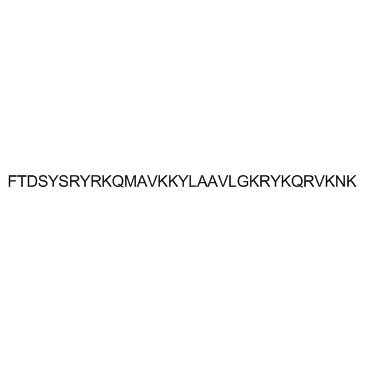| Description |
PACAP (6-38), human, ovine, rat is a potent PACAP receptor antagonist with IC50s of 30, 600, and 40 nM for PACAP type I receptor, PACAP type II receptor VIP1, and PACAP type II receptor VIP2, respectively.
|
| Related Catalog |
|
| Target |
IC50: 30 nM (PACAP type I receptor), 600 nM (PACAP type II receptor VIP1), 40 nM (PACAP type II receptor VIP2)[1]
|
| In Vitro |
An increase of dopamine (DA) content by HPLC analysis and/or cell proliferation identified by MTT assay by Dexamethasone (DEX) is also observed which can be inhibited by PACAP (6-38) at concentration sufficient to block PACAP type 1 (PAC1) receptor. Pretreatment with PAC1 receptor antagonist PACAP (6-38) at 0.1 or 1 μM for 2 h significantly blocks this increase of DA content by 1 μM DEX. The MTT assay shows that DEX increases cell proliferation. Moreover, this action is also inhibited by the pre-incubation of PACAP (6-38). PACAP (6-38) at 1μM shows no effect on DA content and cell proliferation for 24 h. However, PACAP (6-38) at 0.3 μM has been mentioned to reduce the spontaneous tyrosine hydroxylase (TH) accumulation in differentiated retinal cultured cells for 5 days[2].
|
| In Vivo |
Intravesical administration of the PAC1 receptor antagonist, PACAP (6-38) (300 nM), significantly (p≤0.01) increases intercontraction interval (2.0-fold) and void volume (2.5-fold) in NGF-OE mice. Intravesical instillation of PACAP (6-38) also decreases baseline bladder pressure in NGF-OE mice. Intravesical administration of PACAP (6-38) (300 nM) significantly (p≤0.01) reduces pelvic sensitivity in NGF-OE mice but is without effect in WT mice[3].
|
| Cell Assay |
PC12 cells (5×104 cells per well) are deposited in a 96-well flat-bottom culture plate. Cells are incubated with PACAP(6-38) (0.1 and 1.0 μM) for 2 h before the addition of Dexamethasone (DEX, 1 μM). Cells are harvested at 24 h later of treatment. At regular intervals after the additional treatments, 100 μL of 0.2 mg/mL MTT is added per each well, and cells are incubated for 3 h at 37°C. After incubation, the MTT reagent is discarded, and 100 μL of DMSO is then added. The experiment is performed at room temperature for 20 min. The absorbance is then measured with SPECTRA max 340PC ELISA reader at the wavelength of 570 nm[2].
|
| Animal Admin |
Mice[3] Two groups of mice are evaluated: WT mice receiving intravesical administration of vehicle (0.9% saline) and PACAP (6-38) (300 nM) (n=8) and NGF-OE mice receiving intravesical administration of vehicle (0.9% saline) and PACAP (6-38) (300 nM) (n=8). For intravesical administration of PACAP (6-38), mice are anesthetized with 2% isoflurane and PACAP (6-38) (<1.0 mL) is injected through the bladder catheter; the animals are maintained under anesthesia to prevent expulsion of PACAP (6-38) via a voiding reflex. In this procedure, PACAP (6-38) remains in the bladder for 30 min at which time, the drug is drained, the bladder washed with saline and animals recover from anesthesia for 20 min before experimentation[3].
|
| References |
[1]. Gourlet P, et al. Fragments of pituitary adenylate cyclase activating polypeptide discriminate between type I and II recombinant receptors. Eur J Pharmacol. 1995 Dec 4;287(1):7-11. [2]. Yang TT, et al. Changes of dopamine content and cell proliferation by dexamethsone via pituitary adenylate cyclase-activating polypeptide in PC12 cell. Neurosci Lett. 2007 Oct 9;426(1):45-8. [3]. Girard BM, et al. Intravesical PAC1 Receptor Antagonist, PACAP(6-38), Reduces Urinary Bladder Frequency and Pelvic Sensitivity in NGF-OE Mice. J Mol Neurosci. 2016 Jun;59(2):290-9.
|
